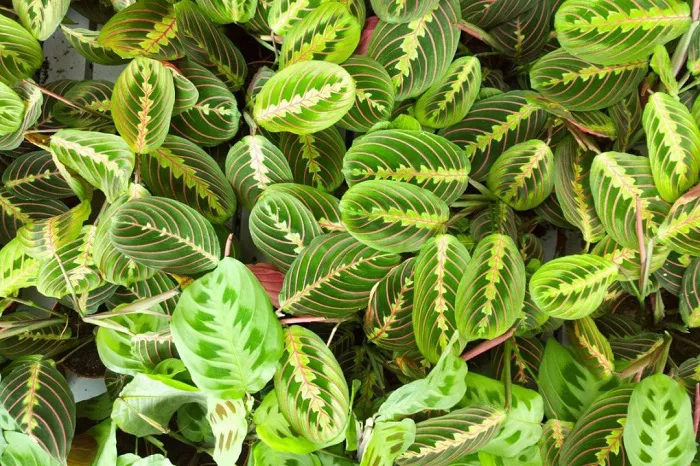Prayer plants, with their mesmerizing foliage and unique movement patterns, have captured the hearts of gardening enthusiasts worldwide. These plants, known for their ability to raise and lower their leaves in response to light, come in a stunning variety of types, each offering its own charm and appeal. From the bold patterns of the Zebra Plant to the elegant stripes of the Calathea orbifolia, there is a prayer plant to suit every style and preference. In this article, we will explore the rich diversity of prayer plants and delve into the characteristics of some of the most popular varieties.
Maranta: The Classic Prayer Plants
Maranta leuconeura ‘Kerchoveana’ (Green Prayer Plant)
The Maranta leuconeura ‘Kerchoveana’ is a delightful variety with light green leaves adorned with darker splotches that resemble the markings of a spotted animal. This plant, also known as the “rabbit tracks” plant, is a favorite for its charming, wild look. It thrives in bright, indirect light and prefers to be kept in a warm spot, away from drafts. The Green Prayer Plant is more forgiving than other varieties, making it an excellent choice for beginners.
Maranta leuconeura ‘Lemon Lime’
The Lemon Lime Prayer Plant is a vibrant addition to any indoor garden. Its leaves are a mix of green, yellow, and lime, creating a refreshing and lively appearance. This variety prefers bright, indirect light and should be watered when the top inch of soil is dry. The Lemon Lime Prayer Plant is relatively easy to care for, making it a great option for adding a pop of color without too much fuss.
Maranta leuconeura ‘Fascinator’
Also known as the “black prayer plant,” the Fascinator features dark green to blackish leaves with a pale green midrib blaze and brightly contrasting reddish-purple veins. This variety has a spreading growth habit and works wonderfully in hanging baskets. It requires similar care to other Maranta varieties, including bright, indirect light and consistent moisture.
Calathea: The Showstoppers
Calathea makoyana (Peacock Plant)
The Calathea makoyana, often called the Peacock Plant, is renowned for its stunning leaf patterns that mimic the feathers of a peacock. This plant is a bit more demanding, requiring high humidity and bright, indirect light. It is sensitive to water quality, so using distilled or rainwater can help prevent leaf spots caused by hard water.
Calathea orbifolia
Calathea orbifolia is the epitome of elegance with its large, round leaves featuring silvery stripes. This variety adds a touch of sophistication to any room. It prefers low to medium indirect light and should be kept in a stable environment to avoid stress. The soil should be kept moist but not soggy, and the plant thrives in warm temperatures.
Calathea zebrina (Zebra Plant)
The Zebra Plant is a standout with its striking striped leaves. The light and dark green stripes resemble a zebra’s coat, creating a bold statement piece for any plant lover’s collection. It prefers medium to bright indirect light and consistent moisture. The Zebra Plant can be finicky about humidity, so keeping it in a bathroom or kitchen with higher humidity levels can help it thrive.
Ctenanthe: The Upright Beauties
Ctenanthe lubbersiana (Bamburanta)
Ctenanthe lubbersiana, commonly known as Bamburanta, is one of the larger species among prayer plants. It has marbled yellow and cream variegation on its medium green foliage. This Brazilian native can grow to be two to four feet tall and two to three feet wide. It prefers bright, indirect light and well-draining soil.
Ctenanthe setosa ‘Grey Star’
The Grey Star variety of Ctenanthe setosa features long elliptical leaves with a pale silver hue, darker leaf veins, and reddish-purple undersides. This plant can reach up to five feet tall and up to three feet wide. It requires similar care to other prayer plants, including bright, indirect light and consistent moisture.
Goeppertia: The Elegant Varieties
Goeppertia orbifolia
Goeppertia orbifolia, formerly known as Calathea orbifolia, has broad, round leaves that are boldly striped in silver and light to dark green. This stunning species, native to eastern Brazil, can grow to be three feet tall with a three-foot spread. It performs well with slightly acidic to slightly alkaline soil.
Goeppertia ornata (Pinstripe Plant)
The Pinstripe Plant, also known as Goeppertia ornata, has dark green, elliptical, pointed leaves with thin, pinkish-white stripes. This variety has an upright growth habit and can reach two to three feet tall with a two to three-foot spread. It is tolerant of slightly acidic to slightly alkaline soil.
Goeppertia roseopicta (Rose-Painted Calathea)
The Rose-Painted Calathea, or Goeppertia roseopicta, features oval-shaped leaves with a feathery cream or pink outline, wide dark and light green stripes, and a bright pink midrib. This species is native to Brazil, Colombia, Ecuador, and Peru. It grows to be 12 to 18 inches tall and has a one-foot spread.
Stromanthe: The Unique Additions
Stromanthe sanguinea ‘Triostar’
Stromanthe sanguinea ‘Triostar’ is a stunning variety with pink, white, and green leaves. This plant is known for its unique coloration and is a great addition to any indoor garden. It prefers bright, indirect light and consistent moisture. The Triostar is a bit more challenging to find but is well worth the effort.
Stromanthe sanguinea ‘Magic Star’
The Magic Star variety of Stromanthe sanguinea features similar coloration to the Triostar but with its own distinct patterns. This plant is less common but equally beautiful, making it a prized addition for plant collectors.
Conclusion
Prayer plants offer a rich variety of species and cultivars, each with its own unique foliage patterns and care requirements. From the classic Maranta varieties to the elegant Calathea species, and the upright Ctenanthe and Stromanthe, there is a prayer plant to suit every gardening style. Whether you are a beginner or an experienced gardener, these plants can bring a touch of nature and beauty into your home. With proper care and attention, prayer plants can thrive and become a focal point in your indoor garden.


